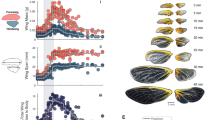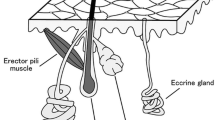Abstract
Cicadas prevent body temperature from exceeding tolerable levels by a combination of behavioral responses and sweating. Sweating is activated when body temperature reaches a critical set-point temperature. We investigated control of sweating in the cicada, Tibicen dealbatus, by chemically manipulating biosynthesis of prostaglandins and other eicosanoids. Injecting prostaglandins in amounts equal to those that induce behavioral fever in scorpions and crustaceans resulted in only a small increase in set-point temperature. Blocking prostaglandin biosynthesis with cyclo-oxygenase inhibitors such as aspirin produced significant changes in set-point temperature, confirming that prostaglandins are involved in control of sweating. However, the effect of cyclo-oxygenase inhibitors was not the opposite of the effect of prostaglandins. Instead, the effect of cyclo-oxygenase inhibitors depended strongly on the value of setpoint temperature prior to treatment. Results of biochemical manipulations of other steps in eicosanoid biosynthetic pathways corroborated the results of cyclo-oxygenase inhibition and indicated that eicosanoids other than prostaglandins may be involved in control of body temperature in normothermic T. dealbatus. The effect of cyclo-oxygenase inhibitors on a given set-point temperature depended on the ambient temperature experienced by cicadas during the experiment. Surprisingly, cicadas exposed to ambient temperatures ≥40°C delayed activation of sweating until body temperature exceeded values normally recorded from T. dealbatus in the field. Control of body temperature in normothermic cicadas is thus complex, involving inputs from body temperature sensors, ambient temperature sensors, and at least two cyclo-oxygenase-dependent regulatory pathways.
Similar content being viewed by others
Abbreviations
- PUFA:
-
polyunsatured fatty acid(s)
- T a :
-
ambient temperature
- T b :
-
body temperature
- T set :
-
set-point of body temperature for activation of sweating
References
Abramson S, Korchak H, Ludewig R, Edelson H, Haines K, Levin RI, Herman R, Rider L, Kimmel S, Weissmann G (1985) Modes of action of aspirin-like drugs. Proc Natl Acad USA 82:7227–7231
Altner H, Loftus R (1985) Ultrastructure and function of insect thermo- and hygroreceptors. Ann Rev Entomol 30:273–295
Cabanac M (1989) Fever in the leech, Nephelopsis obscura (Annelida). J Comp Physiol B 159:281–285
Cabanac M, LeGuelte L (1980) Temperature regulation and prostaglandin E1 fever in scorpions. J Physiol 303:365–370
Casterlin ME, Reynolds WW (1979a) Prostaglandin E1 fever in the crayfish Cambarus bartoni. Pharmacol Biochem Behav 9:593–595
Casterlin ME, Reynods WW (1979b) Fever induced in marine arthropods by prostaglandin E1. Life Sci 25:1601–1604
Cabanac M, Rossetti Y (1987) Fever in snails, reflection on a negative result. Comp Biochem Physiol 87A:1017–1020
Hannegan JL, Heath JE (1970) Temperature dependence of the neural control of the moth flight system. J Exp Biol 53:629–639
Hasting J (1989) Thermoregulation in the dog-day cicada, Tibicen duryi (Homoptera: Cicadidae). Trans Ky Acad Sci 50:145–149
Hastings JM, Toolson EC (1991) Thermobiology of two syntopic cicadas, Tibicen chiricahua and T. duryi (Homoptera: Cicadidae), in central New Mexico. Oecologia 85:513–520
Heath JE, Wilkin PJ (1970) Temperature responses of the desert cicada, Diceroprocta apache (Homoptera: Cicadidae). Physiol Zool 43:145–154
Heath JE, Wilkin PJ, Heath MS (1972) Temperature responses of the cactus dodger, Cacama valvata. Physiol Zool 45:238–246
Heinrich B (1981) Insect thermoregulation. Wiley, New York
Horrobin DF (1978) Prostaglandins, physiology, pharmacology, and clinical significance. The Book Press, Brattleboro, VT, USA
Murphy BF, Heath JE (1983) Temperature sensitivity in the prothoracic ganglion of the cockroach, Periplaneta americana, and its relationship to thermoregulation. J Exp Biol 105:305–315
Petzel DH, Stanley-Samuelson DW (1992) Inhibition of eicosanoid biosynthesis modulates basal fluid secretion in the Malpighian tubules of the yellow fever mosquito (Aedes aegypti). J Insect Physiol 38:1–8
Sanborn AF, Heath JE, Heath MS (1992) Thermoregulation and evaporative cooling in the cicada Okanagodes gracilis (Homoptera: Cicadidae). Comp Biochem Physiol 102A:751–757
Stanley-Samuelson DW (1993) Prostaglandins and related eicosanoids in insects. Adv Insect Physiol
Stanley-Samuelson DW, Howard RW, Toolson EC (1990) Phospholipid fatty acid composition and arachidonic acid uptake and metabolism by the cicada Tibicen dealbatus (Homoptera: Cicadidae). Comp Biochem Physiol 97B:285–292
Stanley-Samuelson DW, Jensen E, Nickerson KW, Tiebel K, Ogg CL, Howard RW (1991) Insect immune response to bacterial infection is mediated by eicosanoids. Proc Natl Acad Sci USA 88:1064–1068
Stanley-Samuelson DW, Loher W (1985) The disappearance of injected prostaglandins from the circulations of adult Australian field crickets, Teleogryllus commodus. Arch Insect Biochem Physiol 2:367–374
Toolson EC (1987) Water profligacy as an adaptation to hot deserts: water loss rates and evaporative cooling in the Sonoran Desert cicada, Diceroprocta apache (Homoptera: Cicadidae). Physiol Zool 60:379–385
Toolson EC, Hadley NF (1987) Energy-dependent facilitation of transcuticular water flux contributes to evaporative cooling in the Sonoran Desert cicada, Diceroprocta apache (Homoptera: Cicadidae). J Exp Biol 131:439–444
Toolson EC, Kuper-Simbron R (1989) Laboratory evolution of epicuticular hydrocarbon composition and cuticular permeability in Drosophila pseudoobscura: effects on sexual dimorphism and thermal-acclimation ability. Evolution 43:468–473
Toolson EC, Toolson EK (1991) Evaporative cooling and endothermy in the 13-year periodical cicada, Magicicada tredecem (Homoptera: Cicadidae). J Comp Physiol B 161:109–115
United States Pharmacoperial Convention, Inc. (1987) USP Dispensing Information (USP DI)—Drug information for the healthcare provider, vol I, 7th edn. 1951 pp
Author information
Authors and Affiliations
Rights and permissions
About this article
Cite this article
Toolson, E.C., Ashby, P.D., Howard, R.W. et al. Eicosanoids mediate control of thermoregulatory sweating in the cicada, Tibicen dealbatus (Insecta: Homoptera). J Comp Physiol B 164, 278–285 (1994). https://doi.org/10.1007/BF00346443
Accepted:
Issue Date:
DOI: https://doi.org/10.1007/BF00346443




